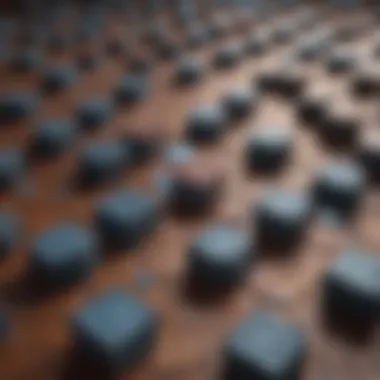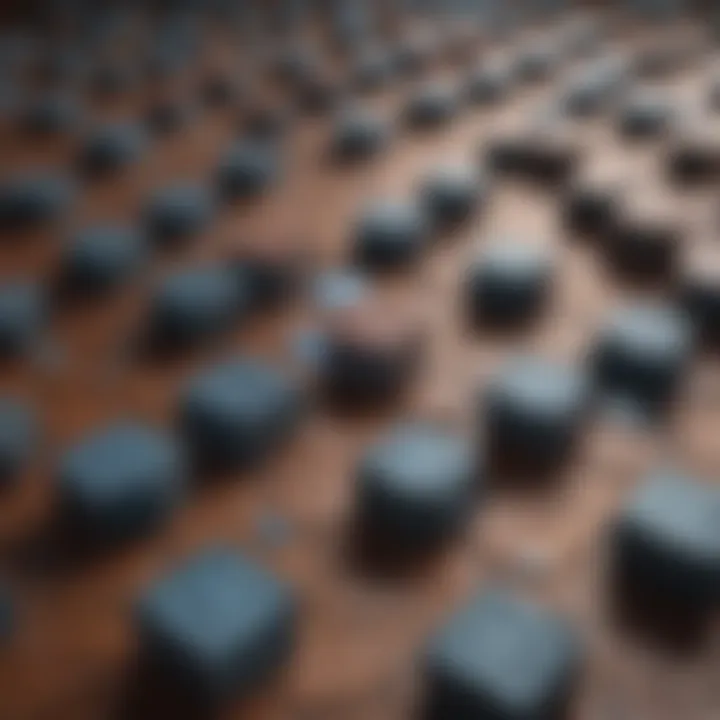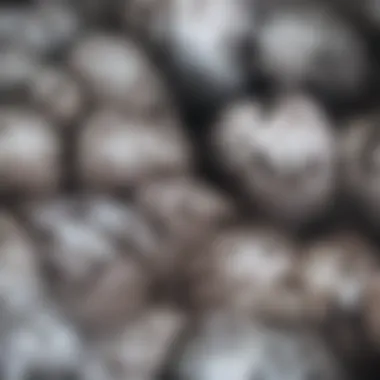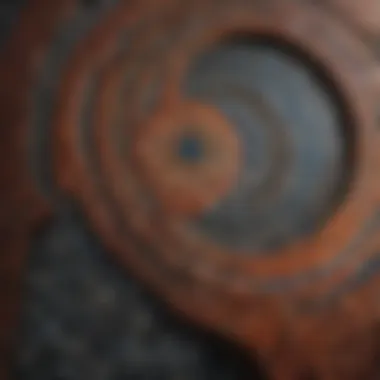Exploring Penrose Tiling: A Comprehensive Overview


Intro
Penrose tiling is a captivating subject that merges art and mathematics in a way that defies conventional understanding of patterns and geometry. At its core, Penrose tiling is a non-periodic tiling generated by an aperiodic set of prototiles. Discovered by the notable mathematician Roger Penrose in the 1970s, this unique structure challenges our perceptions of symmetry, regularity, and pattern formation. The implications of Penrose tiling extend beyond mathematics, influencing fields such as physics, chemistry, and even art.
This article seeks to elucidate the complexities and beauty of Penrose tiling by exploring its mathematical foundations, historical background, and a range of its applications. We aim to provide a thorough overview suitable for students, educators, and enthusiasts alike. By dissecting the key concepts and showcasing significant findings in the field, readers will be well-equipped to understand and appreciate this fascinating phenomenon.
Key Research Findings
The study of Penrose tiling has revealed surprising insights into how complex structures can emerge from simple rules. Below are some of the monumental discoveries related to this area of research.
Overview of Recent Discoveries
Recent research has provided a deeper understanding of Penrose tiling and its mathematical underpinnings. Some critical findings include:
- The relationship between Penrose tiling and quasicrystals, which exhibit similar non-periodic characteristics.
- Advances in computational methods that allow for efficient generation of Penrose tiles, making it easier to explore their properties.
- The realization that Penrose tiling can exhibit self-similar qualities, echoing fractal patterns found in nature.
Significance of Findings in the Field
The significance of these discoveries cannot be overstated. They lay the groundwork for new research in a variety of fields including:
- Mathematics: Understanding complex geometric structures.
- Physics: Exploring the properties of quasicrystals, which have potential applications in material science.
- Art: Influencing modern art styles through unique aesthetic forms that break away from traditional symmetry.
"Explorations in Penrose tiling have bridged gaps between mathematics, physics, and art, revealing interconnectedness in seemingly disparate fields."
Breakdown of Complex Concepts
To fully grasp the implications of Penrose tiling, it is essential to simplify some of the intricate theories associated with it. This section aims to clarify these concepts for a more comprehensive understanding.
Simplification of Advanced Theories
At its essence, Penrose tiling can be understood through a few basic principles:
- Aperiodicity: Penrose tiling does not repeat itself, which is a distinguishing feature from traditional tiling.
- Prototiles: The shapes used, which include the kite and dart, can be arranged to create complex patterns.
- The Matching Rule: This concept uses specific rules for how tiles can be placed next to one another to maintain the aperiodic structure.
Visual Aids and Infographics
Using visual tools can significantly enhance understanding. Diagrams illustrating the arrangement of the kite and dart tiles, alongside the concept of matching rules, are crucial.
- Tile Patterns:
- Self-Similarity: A graphic showing how Penrose tiling produces repeated motifs at different scales can solidify comprehension.
In summary, the journey into the complexity of Penrose tiling unveils a sophisticated interplay of mathematical principles that resonate across multiple disciplines. With a fuller understanding, we can appreciate the elegance and depth inherent in what appears to be simple tiling.
Preface to Penrose Tiling
Penrose tiling stands as a pivotal concept in the field of mathematics and art. It integrates geometric design with mathematical theories, creating a broad canvas for exploration. Understanding Penrose tiling opens the door to a world of aperiodicity, symmetry, and patterns that defy conventional tiling rules. This section will unfold critical aspects that underpin this unique structure and why it captivates both mathematical and artistic communities.
Definition of Penrose Tiling
Penrose tiling is a non-periodic tiling created using two shapes: the fat rhombus and the thin rhombus. These shapes can fit together in ways that fill a plane without repeating patterns, which is a fundamental characteristic of Penrose tiling. This aperiodic nature makes it distinguishable from traditional periodic tiling, where shapes repeat regularly. The mathematical foundations coupled with artistic interviews make Penrose tiling not only an abstract mathematical theory but also a substantial design principle.
Historical Background
Origins of Penrose Tiling
The origins of Penrose tiling can be traced to the work of mathematician Roger Penrose in the 1970s. He discovered a method to create aperiodic patterns using simple shapes. This discovery was substantial because it contradicted the existing understanding of tiling. Prior to this, it was believed that any tiling pattern would eventually lead to some form of periodicity. Penrose's insights showed a new possibility in tiling, where complexity could arise from simple geometric principles.
The main advantage of this discovery is its application across various fields. It influences mathematics, physics, and even art. Penrose tiling emphasizes the connection between geometric complexity and aesthetic pleasure, making it a popular and beneficial topic for exploration in this article.
Key Figures in the Development
Key figures in the development of Penrose tiling extend beyond Roger Penrose himself. Mathematicians and artists, such as John H. Conway and Charles Radin, contributed significantly to its theories and applications. Their work helped in formalizing the rules of tiling and investigating its mathematical implications.


The collaborative efforts of these individuals have brought Penrose tiling into broader discourse in mathematics. It is noteworthy because it casts a wider net in research that delves into symmetries and aperiodic order. These enrich the understanding of how tiling principles apply not just in theory but in real-world materials and structures as well.
"Penrose tiling exemplifies a deep connection between mathematical patterns and their artistic expressions."
This convergence of mathematics and art renders Penrose tiling a substantial choice for comprehensive exploration in this article, covering both historical and modern contexts.
Mathematical Concepts in Penrose Tiling
Mathematical concepts play a crucial role in the understanding of Penrose tiling. They form the backbone of why these patterns are so intriguing. The study of Penrose tilings goes beyond just arranging shapes. It involves delving into deeper mathematical theories and frameworks that guide their structure and behavior. This exploration helps to understand not only Penrose tiling itself but also broader implications in mathematics, physics, and material sciences.
Aperiodicity and Quasicrystals
Aperiodicity is a central concept in the realm of Penrose tiling. Unlike periodic tiling, where patterns repeat regularly, Penrose tiling introduces a unique structure that never fully repeats yet maintains order. This property is essential in quasicrystals, materials that exhibit ordered structures without a repeating unit cell. The Fibonacci sequence often serves as a model for aperiodic structures. The aperiodic nature presents both challenges and opportunities in various scientific fields. For example, it provides insights into atomic arrangements in quasicrystalline materials.
One significant aspect of aperiodicity is how it influences physical properties. Aperiodic arrangements can lead to distinct optical and thermal behaviors. This stands in sharp contrast to traditional crystals, where repeating patterns dominate. Understanding aperiodicity helps extend our comprehension of materials in condensed matter physics. In this way, Penrose tilings bridge the gap between pure mathematics and applied sciences.
"Aperiodic tiling allows us to explore ordered patterns that defy conventional periodicity, pushing the boundaries of material science."
Symmetry and Group Theory
Symmetry is another vital concept tied to Penrose tilings. Penrose tilings exhibit a type of symmetry that does not conform to traditional forms. Instead of repeating patterns, they maintain a form of order through non-periodic symmetry. This uniqueness makes them a rich field for exploration within group theory, allowing mathematicians to classify and analyze their structures mathematically. Understanding symmetry provides essential insights into the properties of Penrose tiling. It helps explain how different tilings relate and interact with each other.
Group theory also enables the classification of the symmetries found in Penrose tiling. By employing groups, mathematicians can map the transformations of tiles within the pattern. This mapping is crucial for understanding the underlying structure of Penrose tiling. Group theory not only applies to Penrose tiling but extends its reach to many areas within mathematics and physics. Utilizing this mathematical language aids in articulating concepts that are otherwise complex.
In examining the symmetry in Penrose tilings, researchers can draw connections to many domains, such as crystallography and theoretical physics. These insights highlight the importance of mathematical concepts in understanding intricate structures and their applications in real-world phenomena.
Types of Penrose Tilings
Understanding the types of Penrose tilings is essential in grasping the complexity and beauty of aperiodic patterns. Different forms of tiling reveal varying approaches to achieve non-repeating designs, leading to significant implications in mathematics, physics, and even art. Each type of Penrose tiling has its own construction methods and properties, making them valuable in research and practical applications. By studying these types, one can appreciate how they contribute to the understanding of aperiodicity and symmetry. Below, we delve into two primary variations: Rhombic Penrose Tiling and Dart and Kite Tiling.
Rhombic Penrose Tiling
Rhombic Penrose Tiling employs two different types of rhombuses, which are shaped distinctively to create a non-periodic pattern. The angles of these rhombuses are 36 degrees and 144 degrees, and 72 degrees and 108 degrees. Such shapes allow for intricate arrangements while ensuring that no repetition occurs. This specific tiling method plays a vital role in demonstrating the phenomenon of aperiodicity, where the overall pattern does not exhibit a translational symmetry.
To construct Rhombic Penrose Tiling, specific matching rules must be followed. These rules dictate how the rhombuses can be placed next to each other, maintaining the non-periodic nature. The beauty of this form comes from how it can cover a plane without gaps or overlaps, a challenge that has implications in various scientific fields. Notably, this tiling method can be observed in nature, including various quasicrystals, which mimic this non-periodic structure in atomic arrangements.
Dart and Kite Tiling
Dart and Kite Tiling offers another view of Penrose tiling. This method utilizes two shapes: the dart and the kite, which together form a complex arrangement. The dart shape resembles a dart used in games, while the kite has a more diamond-like form. The distinct combination of these shapes enables a rich structure that maintains a non-repetitive pattern.
The construction of Dart and Kite Tiling is based on specific matching rules as well, which helps to enforce the distinct arrangement of the darts and kites. The pairing creates a rich tapestry of interlocking shapes, which can create different visual effects and enhance geometric properties. These tilings have seen application not only in theoretical studies but also in art and design, where their unique patterns can echo modern aesthetics.
Both types of Penrose tilings provide invaluable insight into the mathematical properties of non-periodic patterns. They serve as practical examples of how complex arrangements can arise from simple geometric shapes, aligning with principles that span across multiple scientific disciplines.
Constructing Penrose Tilings
Constructing Penrose tilings is a fundamental topic that enhances understanding of the mathematical concepts associated with this unique type of tiling. At its core, Penrose tiling disregards traditional periodicity, creating a fascinating pattern formed by specific rules. This construction process not only illustrates important mathematical ideas but also reveals practical applications in various fields. By examining the methods of constructing Penrose tilings, we can appreciate both their aesthetic qualities and their practical implications.
Edge Matching Rules
Edge matching rules are critical to the construction of Penrose tilings. These rules dictate how tiles can be arranged without creating conflicts in alignment or pattern. In the case of Penrose tilings, tiles must be placed so that their colored edges correspond. For example, a tile colored with a blue edge must be adjacent to another tile that has a blue edge available for connection. This principle of adjacency is crucial for maintaining the non-periodic nature of the tiling.
The edge matching rules help ensure that when placing tiles, the specific angles and proportions align correctly. These restrictions are what differentiate Penrose tiling from conventional tiling methods. The unique attributes give rise to the non-repetitive nature observed in Penrose patterns. Here are some key points to consider about edge matching rules:
- They promote a non-periodic structure, essential for defining Penrose tiling.
- Ensuring the correct adjacency leads to intricate patterns that can be visually and mathematically studied.
- The rules often involve specific colorings or symmetries that are inherent to the tiles used.
In practical terms, creating computer algorithms often makes these rules easier to apply. Algorithms can generate infinite non-repeating patterns based on the edge matching rules. This capability opens new avenues for creativity in art and design while adhering to established mathematical principles.
Ammann-Beenker Tiling
Ammann-Beenker tiling is a specific type of Penrose tiling that serves as a notable example of aperiodic tiling. It is known for its unique geometric properties and broader symmetry. This tiling pattern consists of rhombuses arranged in a sequence based on specific angular relationships, allowing it to effectively fill space without periodic repetition. The Ammann-Beenker configuration typically utilizes specific angles, leading to its distinct visual appearance.
One advantage of this type of tiling is its structural flexibility, making it applicable in various scientific fields. In architecture, for example, the Ammann-Beenker design can be used to create aesthetically pleasing and functionally strong structures. Moreover, the mathematical properties of this tiling illuminate certain concepts in aperiodic tiling theory, offering insights into how complex systems can form from simple rules.


The application of Ammann-Beenker tiling can also push the boundaries in materials science, where understanding the interaction of aperiodic structures with physical properties is key. This tiling type highlights how mathematical constructs can bridge abstract theory and applied science, paving the way for advancements in multiple disciplines.
Applications of Penrose Tiling
Understanding the applications of Penrose tiling is crucial. This phenomenon is more than just a mathematical curiosity; its implications extend into diverse fields such as physics, architecture, and materials science. These applications demonstrate how mathematical concepts can influence practical developments and advancements in technology. By exploring these areas, we can appreciate the aesthetic and functional benefits that Penrose tiling brings.
Applications in Physics
In physics, Penrose tiling plays a substantial role in understanding quasicrystals. Quasicrystals are materials that exhibit aperiodic but structured arrangements of atoms. This property is fundamental in explaining certain physical phenomena. Penrose tiling provides a model for these structures, showing how they can form without repeating patterns. Researchers have shown that the unique arrangements lead to unusual properties, such as lower thermal conductivity and higher strength. These features make quasicrystals interesting for applications in various technologies, ranging from light-emitting diodes to surgical instruments.
Use in Architecture and Art
Architecture and art benefit significantly from the principles of Penrose tiling. Many architects incorporate these non-repeating patterns into their designs. The unique arrangements add visual appeal while creating structures that are stable yet aesthetically intriguing. Notable architects, like Michael Barnsley, have used Penrose tiling to design buildings that interact dynamically with their environments. On the artistic front, artists like Escher have drawn inspiration from these patterns, using them in various works. This connection between mathematics and art showcases how Penrose's ideas can inspire innovative designs and expressive forms.
Role in Materials Science
In materials science, Penrose tiling is vital for understanding complex solids and the arrangements of atoms in different materials. The unique properties derived from the order and aperiodicity of Penrose structures allow for the design of new materials with tailored properties. For example, research into Penrose tiling contributes to developing novel insulators and semiconductors that can be applied in the electronics industry. The relationship between atomic structure and material properties emphasizes the importance of Penrose tiling in ongoing scientific advancements.
"Understanding Penrose tiling and its applications not only enriches theoretical mathematics but provides concrete benefits across various industries."
Penrose Tiling and Computer Science
The intersection of Penrose tiling and computer science represents a fascinating area of study. It opens doors for understanding aperiodic structures, which have unique properties and implications in various domains, including algorithm design and theoretical applications. Penrose tiling serves as a perfect example of how mathematics can influence computer science, especially with regards to generating complex forms and modeling intricate systems. By embracing Penrose tiling, researchers can uncover insights related to computational efficiency and geometric structures.
Algorithms for Tiling Generation
Generating Penrose tilings requires intricate algorithms that adhere strictly to the rules of tiling. These algorithms are built on edge-matching rules that define how tiles should fit together without gaps or overlaps. A prominent approach involves using substitution rules where larger patterns can be generated from smaller seed tiles. Here are a few points on this topic:
- Algorithm Types: There are several types of algorithms such as recursive algorithms, randomized algorithms, and deterministic tile generation methods. Each has its benefits depending on the desired outcome.
- Complexity Management: The challenge lies in managing the complexity while ensuring that the generated patterns maintain the non-periodic nature characteristic of Penrose tiling.
- Performance Consideration: Efficient algorithms consider the computational cost and speed, thus allowing for faster generation of larger patterns.
Researchers employ programming languages such as Python and Java for tile generation algorithms. These languages provide libraries and tools that can facilitate the mathematical computations required for Penrose tiling.
Modeling Aperiodic Structures
Modeling aperiodic structures using Penrose tiling has profound implications in computer science. This modeling supports various fields, particularly in fields such as condensed matter physics and materials science. One significant aspect of modeling is the demonstration of how aperiodic structures can represent systems that are not periodic yet possess order. Here are insights into this modeling:
- Simulation Frameworks: Here, frameworks like Computational Geometry or Graph Theory can be applied to understand the relationships between tiles in a non-periodic pattern.
- Real-World Applications: Understanding aperiodic structures through Penrose tiling can lead to advancements in material design, where the unique properties of these structures manifest in physical applications.
- Implications for Algorithms: The study of these structures influences algorithm efficiency, specifically in optimizations that deal with search and pattern recognition tasks.
"The study of Penrose tiling in computer science has led to advancements in algorithms related to aperiodic structures, fostering deeper understanding across multiple scientific domains."
In light of these considerations, the exploration of Penrose tiling enriches the landscape of computer science, making it an exciting area for future research and practical application.
Theoretical Implications of Penrose Tiling
Penrose tiling extends beyond mere aesthetics and mathematical curiosity. It possesses substantial theoretical implications that enrich our understanding of various mathematical disciplines, particularly number theory and mathematical physics.
These implications allow for an exploration of intrinsic mathematical properties, resonating with wide-ranging concepts. In this section, we will discuss how Penrose tiling connects to number theory and provide insights into mathematical physics, illustrating its relevance in contemporary research.
Connection to Number Theory
Penrose tiling serves as a potent example within number theory. The structure of its tiling patterns showcases fascinating relationships between geometry and numerical properties. The non-periodicity found in Penrose tiling evokes discussions surrounding irrational numbers, particularly the golden ratio.
The definitions of the tiles used, particularly the rhombuses, relate to irrational angles, which can be analyzed using various numerical methods. Consider the role of the golden ratio, approximately 1.618, which appears in the proportions of many of these tiles. This can lead us toward a deeper understanding of how number theory interacts with geometry in a real-world context.
Key considerations in this connection include:
- Irrationality: The angles involved lead to a deeper appreciation of irrational numbers.
- Countability: The exploration of non-periodic structures offers insights into different aspects of countability in mathematics.
- Tiling as a Representation: Each configuration can be considered a representation of a number system, revealing how abstract ideas can materialize in visual form.
Insights into Mathematical Physics
The interplay of Penrose tiling with mathematical physics provides critical insights into the nature of matter and space. Understanding non-periodic structures enhances theories concerning quasicrystals, which possess atomic arrangements similar to those seen in Penrose tiling.


For example, mathematical physics employs Penrose tiling to explain the characteristics of materials that do not follow traditional crystalline symmetry. Quasicrystals possess unique properties which defy classical understanding. This connection emphasizes the role of Penrose tiling in theoretical physics, particularly in regards to condensed matter and statistical mechanics.
Furthermore, notable points include:
- Material Properties: Investigating how non-periodic structures influence conductivity and other physical properties.
- Quantum Mechanics: Penrose tiling discussions often touch upon implications for quantum states and their arrangements.
- Cosmological Models: Some theoretical frameworks even propose that the universe may be modeled using similar non-periodic structures.
"Penrose tiling offers not only a glimpse into mathematical beauty but also a window into the deep connections between various branches of science."
Through these discussions, it becomes clear that Penrose tiling is not merely a subject of mathematical intrigue but a tool fostering cross-disciplinary dialogue in science and mathematics. Its theoretical implications prompt ongoing investigation and inspire new approaches in both number theory and mathematical physics.
Challenges and Questions in Penrose Tiling
Understanding the challenges associated with Penrose tiling is crucial for both researchers and enthusiasts. This area of study involves complex mathematical concepts and raises several intriguing open questions. The exploration of these challenges can uncover deeper insights into the properties of aperiodic tilings and their implications across various scientific fields.
Open Problems in Tiling Theory
One notable challenge involves the classification of all possible Penrose tilings. While mathematicians have identified several types, the full spectrum remains an open question. Specifically, researchers ask:
- What are all distinct forms of Penrose arrangements that maintain their aperiodic nature?
- Can a systematic way to generate new Penrose tilings be established?
Additionally, the issue of defect management is significant. In practical applications, tiles might not be placed perfectly, leading to defects in the tiling pattern. This brings about the following questions:
- How do defects influence the mathematical properties of the overall tiling?
- Are there stable configurations that can tolerate defects?
The study of aperiodicity poses another challenge. How can we effectively model and predict the behavior of Penrose tilings in interaction with other mathematical structures? Each question opens avenues for more investigation.
Future Directions for Research
The future of research in Penrose tiling looks promising. Scholars are increasingly interested in integrating insights from various disciplines such as computational geometry and materials science. Below are some potential research directions:
- Computer Simulations: Advanced computation techniques can help visualize and predict behaviors in Penrose tiling. These simulations can explore how tilings change under various constraints or environmental conditions.
- Material Applications: There is potential to harness the unique properties of Penrose tilings in new material designs. Exploring how these tilings interact at a molecular level could lead to innovative forms of materials with unique properties.
- Connections to Other Mathematical Areas: Further investigations can be directed toward understanding the relationship between Penrose tilings and other fields like number theory and mathematical physics. Exploring these connections will enrich the understanding of both Penrose tiling and its broader mathematical context.
"The pursuit of understanding Penrose tilings leads researchers into uncharted mathematical territory. Each inquiry into its complexity reveals more about the universe's order and chaos."
In summary, the challenges and questions in Penrose tiling are not just academic. They serve as a foundation for ongoing research that marries mathematics and real-world application. Such inquiries not only hold potential for new discoveries but also inspire interdisciplinary approaches to problem-solving.
Educational Resources on Penrose Tiling
Understanding Penrose tiling is complex, yet educational resources can greatly aid in grasping its intricacies. These resources help to illustrate the mathematical concepts, historical significance, and practical applications associated with Penrose tiling. Students, researchers, and educators can immensely benefit from well-structured materials that present this topic in an engaging and informative manner. Additionally, these resources encourage exploration and foster a deeper appreciation for aperiodicity in mathematics.
Books and Articles
Books and articles provide essential insights into Penrose tiling. Comprehensive texts often cover both theoretical frameworks and practical applications, enhancing understanding across diverse audiences.
- "Tilings and Patterns" by Jeffrey C. Lagarias: This book offers an extensive analysis of tiling theory with a segment dedicated to Penrose tiling.
- "Penrose Tiles and the Empirical Evidence" by Peter J. Lu and Paul J. Steinhardt: This article discusses experimental validation of Penrose tiling, turning abstract concepts into concrete examples.
- Research papers: Scholarly articles found in online databases like JSTOR often provide current investigations and findings about Penrose tiling.
These resources serve not only to inform but also to inspire further inquiry.
Online Courses and Lectures
Online courses and lectures can be valuable for those seeking structured education on Penrose tiling. Platforms such as Coursera and edX often offer mathematics courses that include sections on aperiodic tilings.
- Coursera's Mathematical Thinking: This course introduces a variety of mathematical ideas where Penrose tiling is discussed as part of a broader curriculum.
- YouTube Lectures: Educators like Nikhil K. Bhatt post detailed explanations and explorations of Penrose tiling concepts, allowing visual learners to absorb information more effectively.
These digital resources help create a flexible learning environment, allowing learners to engage with the material at their own pace while deepening their understanding of Penrose tiling.
Finale
In exploring Penrose tiling, it is crucial to appreciate its multifaceted nature and significance within both mathematics and various applied fields. This article underlines the importance of Penrose tiling not just as a mathematical curiosity, but as a concept that invites deeper investigation into aperiodic structures, symmetry, and their implications in numerous disciplines.
The uniqueness of Penrose tiling lies in its non-periodic arrangement of shapes, which challenges traditional notions of symmetry and repetitive patterns. It opens up a dialogue about the nature of order and chaos, shedding light on how seemingly complex structures can emerge from simple rules. This aspect makes Penrose tiling relevant for mathematicians, artists, and scientists alike who seek to understand the complexities of the world around them.
Benefits of Understanding Penrose Tiling:
- Inspires Creativity: The aesthetic appeal of Penrose tiling has a profound impact on art and design, encouraging innovative approaches to visual expression.
- Promotes Interdisciplinary Studies: It creates connections between mathematics, physics, material science, and art, fostering collaborative solutions to problems that span multiple fields.
- Enhances Critical Thinking: Analyzing the properties and implications of aperiodic tilings encourages individuals to think critically about patterns, sequences, and anomalies in both theoretical and practical contexts.
As we conclude this comprehensive overview, it is essential to recognize the ongoing questions and challenges that Penrose tiling presents. Future research may lead to deeper insights into its applications and theoretical foundations. Embracing this legacy offers a pathway for both scholars and enthusiasts to engage with the ever-evolving narrative of mathematics and art.
In summary, the explorations into the world of Penrose tiling highlight its profound significance. Understanding its principles not only cultivates a deeper appreciation of complex structures but also engages us in a broader examination of how mathematics influences various aspects of our lives.















